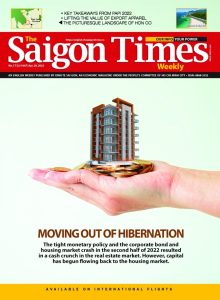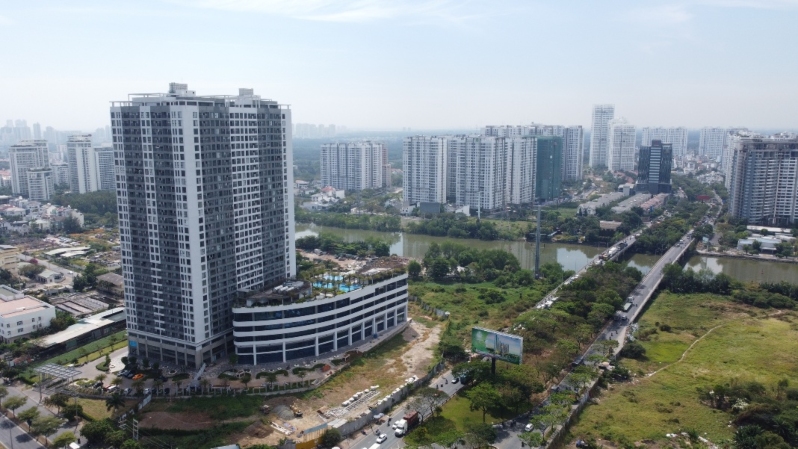The tight monetary policy and the corporate bond and housing market crash in the second half of 2022 resulted in a cash crunch in the real estate market. However, capital has begun flowing back to the housing market.
Capital flows back
Data from the Ministry of Finance showed that corporate bond issues in January-March totaled VND24,708 billion. When Government Decree 08 came into force on March 6, VND23,825 billion worth of corporate bonds found buyers, or around 96% of the total first-quarter value. Over VND24,000 billion, or 98.2% of the total, was issued by real estate firms, with banks acquiring 77%.
Meanwhile, data from the State Bank of Vietnam (SBV) showed outstanding loans for the real estate sector as of late February inched up 2.19% compared to late 2022, at VND2,600 trillion, accounting for 33% of the total in the economy.
By the end of the first quarter, loans for the real estate sector rose by 3% over late 2022, equivalent to an increase of VND77 trillion. This means the sector raised a total of over VND100 trillion from bank loans and bond sales between January and March.
However, foreign investment in the quarter remained weak. According to the General Statistics Office, fresh foreign investment approvals in Vietnam as of March 20, including newly registered capital, capital increases and contributions and stake acquisitions from companies active in the country, plunged by 38.8% year-on-year to US$5.45 billion.
The real estate sector came in second with total pledged capital of US$766 million, plummeting 72% against the same period last year and accounting for 14.1% of the total newly registered capital. Disbursements amounted to US$228.5 million, making up 5.3%.
The financing structure of the real estate sector has changed over the years. Dr. Can Van Luc, a National Financial and Monetary Policy Advisory Council member, pointed out this change at a recent conference on funding sources for the real estate sector.
In 2021, bank loans accounted for 46.4% of the financing structure of the real estate sector while corporate bonds and foreign investments made up 31.1% and 12.1%, respectively. In the following year, bank loans for the sector surged to around 74%.
The sector raised a combined VND338 trillion from bond sales from 2017 to the first quarter of 2023, with a spike in corporate bond issues in 2021, at VND214 trillion. Most of them come with tenors of three or four years, so VND120 trillion worth of bonds would fall due this year. So far, 8% of the bonds have been overdue.
“Bank loans for the real estate sector in Vietnam remain below average compared to other countries. This means that it is possible to lend more to the sector, but doing so requires risk classification for each segment,” Luc said. Despite the SBV’s 2023 credit growth target of 14-15%, real estate loans should be increased.
Credit growth and policy measures would be two factors that can help accelerate the improvement of the real estate sector in 2023, as easing control over how funds are raised has brought capital back to the housing market.
Light at the end of the tunnel
The Government has enabled businesses to restructure debt and thus helped the real estate market improve in the first quarter. As fundraising channels have shown signs of improvement, analysts expect liquidity to return to the market soon. Investor confidence has also strengthened, as reflected in the recent increase in sales.
According to Pham Anh Khoi, head of the Finance – Economics – Real Estate Institute of Dat Xanh Services, property transactions have increased since the Lunar New Year holiday early this year. Some member companies of Dat Xanh Services sold over 100 products in the final 10 days of March. Though sales remain modest, they keep increasing day by day, giving hope to property brokers after months of inactivity on the market.
The market has seen an improvement in liquidity after the SBV revised down key interest rates, resulting in banks lowering interest rates. However, more is needed to be done to bring the market out of the woods as investor sentiment remains dismal, and it would be tough to access cheap capital in the following quarters.
Banks would need more time to cut lending rates despite deposit rate reductions. Thus, lending rates are seen hovering around 9-10% per year in the second quarter.
“The real estate market recovery would only manifest when lending rates fall below 10%. This is the rate borrowers can tolerate when taking out loans,” Khoi said, adding that the final months of 2023 will be a pivotal time to determine whether capital will return to the real estate market, as bank deposits will fall due.
Nguyen Van Dinh, chairman of the Vietnam Association of Realtors, said liquidity would improve as new regulations and efforts of market players, observers and policymakers produce results. But time will tell. The market is waiting for the Government to cut red tape and streamline investment and development project procedures.
 At a recent conference, Nguyen Manh Khoi, deputy director of the Housing and Real Estate Market Management Department at the Ministry of Construction, said that it might take six months for the new policy to produce results and may need more time for a ripple effect.
At a recent conference, Nguyen Manh Khoi, deputy director of the Housing and Real Estate Market Management Department at the Ministry of Construction, said that it might take six months for the new policy to produce results and may need more time for a ripple effect.
“The real estate market would fluctuate. From a policymaker’s perspective, the market may bounce back in the fourth quarter due to positive factors brought by public investment disbursement, social housing development and the handling of legal problems,” he said.
In the quarter-one market report, researchers said that cheap capital might return to the market if deposit rates hover around 6-7% at the end of the year. Past capital flows indicate that the stock market would absorb surplus capital on the market and grow first, and then flow to the real estate market. Thus, the real estate recovery cycle might begin next year.











